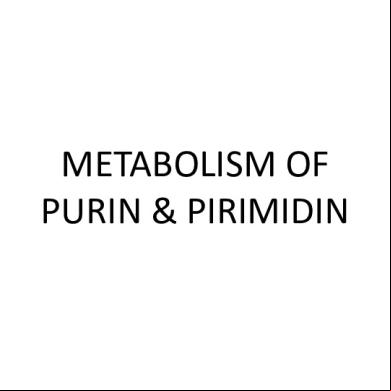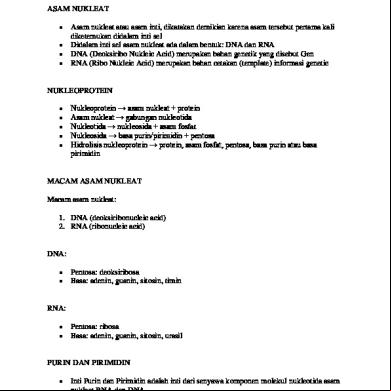Metabolism Of Purin Pirimidin 4s1j1s
This document was ed by and they confirmed that they have the permission to share it. If you are author or own the copyright of this book, please report to us by using this report form. Report 2z6p3t
Overview 5o1f4z
& View Metabolism Of Purin Pirimidin as PDF for free.
More details 6z3438
- Words: 1,080
- Pages: 36
METABOLISM OF PURIN & PIRIMIDIN
Metabolism of Nucleotides
N
N
N
N
N H
N
Nucleoside and Nucleotide Nucleoside =
Nitrogenous base ribose
Nucleotide =
Nitrogenous base ribose phosphate
Purines vs Pyrimidines
Degradation of nucleic acid Nucleoprotein
In stomach
Gastric acid and pepsin
Nucleic acid
In small intestine
Protein
Endonucleases: RNase and DNase
Nucleotide
Nucleotidase Phosphate
Nucleoside
Nucleosidase
Base
Ribose
Significances of nucleotides 1. Precursors for DNA and RNA synthesis
2. Essential carriers of chemical energy, especially ATP 3. Components of the cofactors NAD+, FAD, and coenzyme A
4. Formation of activated intermediates such as UDP-glucose and CDP-diacylglycerol. 5. cAMP and cGMP, are also cellular second messengers.
Synthesis of Purine Nucleotides
There are two pathways leading to nucleotides • De novo synthesis: The synthesis of nucleotides begins with their metabolic precursors: amino acids, ribose-5-phosphate, CO2, and one-carbon units.
• Salvage pathways: The synthesis of nucleotide by recycle the free bases or nucleosides released from nucleic acid breakdown.
§ 2.1 De novo synthesis • Site: – in cytosol of liver, small intestine and thymus
• Characteristics: a. Purines are synthesized using 5phosphoribose(R-5-P) as the starting material step by step. b. PRPP(5-phosphoribosyl-1-pyrophosphate) is active donor of R-5-P. c. AMP and GMP are synthesized further at the base of IMP(Inosine-5'-Monophosphate).
1. Element sources of purine bases
N10-Formyltetrahydrofolate
N10-Formyltetrahydrofolate
First, synthesis Inosine-5'-Monophosphate, IMP
2. Synthesis of Inosine Monophosphate (IMP) • Basic pathway for biosynthesis of purine ribonucleotides • Starts from ribose-5-phosphate(R-5-P) • Requires 11 steps overall • occurs primarily in the liver
3. Conversion of IMP to AMP and GMP Note: GTP is used for AMP synthesis.
Note: ATP is used for GMP synthesis.
IMP is the precursor for both AMP and GMP.
4. ADP, ATP, GDP and GTP biosynthesis kinase
kinase
AMP
ATP
ADP
ADP
ATP
ATP
kinase
ADP
kinase GTP
GDP
GMP
ATP
ADP
ATP
ADP
5. Regulation of de novo synthesis The significance of regulation: (1) Meet the need of the body, without wasting. (2) AMP and GMP control their respective synthesis from IMP by a mechanism, [GTP]=[ATP]
§ 2.2 Salvage pathway • Purine bases created by degradation of RNA or DNA and intermediate of purine synthesis can be directly converted to the corresponding nucleotides. • The significance of salvage pathway : – Save the fuel. – Some tissues and organs such as brain and bone marrow are only capable of synthesizing nucleotides by salvage pathway.
• Two phosphoribosyl transferases are involved: – APRT (adenine phosphoribosyl transferase) for adenine. – HGPRT (hypoxanthine guanine phosphoribosyl transferase) for guanine or hypoxanthine.
Purine Salvage Pathway . adenine phosphoribosyl transferase
Adenine
PRPP
AMP
PPi O N
O N
2-O
N
N N Hypoxanthine O N N
hypoxanthine-guanine phosphoribosyl transferase (HGPRT)
PRPP N
N
Guanine
NH2
3POH2C
O
N
N
N
HO OH IMP O
PPi
N 2-O
3POH2C
O
N
N N
NH2
HO OH GMP
.
Absence of activity of HGPRT leads to Lesch-Nyhan syndrome.
§ 2. 3 Formation of deoxyribonucleotide • Formation of deoxyribonucleotide involves the reduction of the sugar moiety of
ribonucleoside diphosphates (ADP, GDP, CDP or UDP).
• Deoxyribonucleotide synthesis at the nucleoside diphosphate(NDP) level.
§ 2. 4 Antimetabolites of purine nucleotides • Antimetabolites of purine nucleotides are structural analogs of purine, amino acids and folic acid. • They can interfere, inhibit or block synthesis pathway of purine nucleotides and further block synthesis of DNA, RNA, and proteins. • Widely used to control cancer.
Degradation of Purine Nucleotides
NH2
Adenosine N Deaminase
C N
C
O C HN
C
N CH
CH HC
C
HC
N
N
C N
O
N Ribose-P
Ribose-P IMP
AMP
C HN
CH HC
C
C
N
HN C
C O
C N H
N H Hypoxanthine
O
C HN
C
N
Xanthine Oxidase O
C
N H
Uric Acid (2,6,8-trioxypurine)
C
N
O
CH C O
C N H
N
N H
Xanthine The end product of purine metabolism
GMP
Uric acid • Uric acid is the excreted end product of purine catabolism in primates, birds, and some other animals. • The rate of uric acid excretion by the normal adult human is about 0.6 g/24 h, arising in part from ingested purines and in part from the turnover of the purine nucleotides of nucleic acids. • The normal concentration of uric acid in the serum of adults is in the range of 3-7 mg/dl.
Synthesis of Pyrimidine Nucleotides
§ 4.1 De novo synthesis • shorter pathway than for purines • Pyrimidine ring is made first, then attached to riboseP (unlike purine biosynthesis) • only 2 precursors (aspartate and glutamine, plus HCO3-) contribute to the 6-membered ring • requires 6 steps (instead of 11 for purine) • the product is UMP (uridine monophosphate)
1. Element source of pyrimidine base
C Gln
N3
4
5C
Asp CO 2
C2
1
N
6C
Step 1: synthesis of carbamoyl phosphate
•Carbamoyl phosphate synthetase(S) exists in 2 types: •S-I, a mitochondrial enzyme, is dedicated to the urea cycle and arginine biosynthesis. •S-II, a cytosolic enzyme, used here. It is the committed step in animals.
Step 2: synthesis of carbamoyl aspartate ATCase: aspartate transcarbamoylase
•Carbamoyl phosphate is an “activated” compound, so no energy input is needed at this step.
Step 3: ring closure to form dihydroorotate
Step 4: oxidation of dihydroorotate to orotate
CoQ QH2
(a pyrimidine)
Step 5: acquisition of ribose phosphate moiety
Step 6: decarboxylation of OMP
The big picture
3. UTP and CTP biosynthesis kinase
kinase UMP
UDP
ATP
ADP
UTP
ATP
ADP
4. Formation of dTMP The immediate precursor of thymidylate (dTMP) is dUMP. The formation of dUMP either by deamination of dCMP or by hydrolyzation of dUDP. The former is the main route. UDP
dUDP
dCMP
dCDP
dUMP
N5,N10-methylenetetrahydrofolic Acid dTMP synthetase
dTMP
ATP
dTDP
ADP
ATP
dTTP
ADP
§ 4. 2 Salvage pathway uridine-cytidine kinase uridine cytidine + ATP deoxythymidine + ATP deoxycytidine + ATP
uracil thymine + PRPP orotic acid
thymidine kinase deoxycytidine kinase pyrimidine phosphate ribosyltransferase
UMP + ADP CMP dTMP + ADP dCMP + ADP
UMP dTMP + PPi OMP
§ 4. 3 Antimetabolites of pyrimidine nucleotides • Antimetabolites of pyrimidine nucleotides are similar with them of purine nucleotides.
Degradation of Pyrimidine Nucleotides
O
NH2 N O
H2O
N H cytosine
NH3
O
HN O
uracil
HN N H
O
HOOC
O
N H
N H
CH2
NH2 CH CH3 O
N H
H2O H2N CH2 CH2 COOH
thymine
HOOC
NH2 CH2
¦Â-ureidopropionate
CH3
CH2 ¦Â-ureidoisobutyrate H2O
CO2 + NH3
H2N CH2 CH COOH
¦Â-alanine
Highly soluble products
CH3 ¦Â-aminoisobutyrate
Metabolism of Nucleotides
N
N
N
N
N H
N
Nucleoside and Nucleotide Nucleoside =
Nitrogenous base ribose
Nucleotide =
Nitrogenous base ribose phosphate
Purines vs Pyrimidines
Degradation of nucleic acid Nucleoprotein
In stomach
Gastric acid and pepsin
Nucleic acid
In small intestine
Protein
Endonucleases: RNase and DNase
Nucleotide
Nucleotidase Phosphate
Nucleoside
Nucleosidase
Base
Ribose
Significances of nucleotides 1. Precursors for DNA and RNA synthesis
2. Essential carriers of chemical energy, especially ATP 3. Components of the cofactors NAD+, FAD, and coenzyme A
4. Formation of activated intermediates such as UDP-glucose and CDP-diacylglycerol. 5. cAMP and cGMP, are also cellular second messengers.
Synthesis of Purine Nucleotides
There are two pathways leading to nucleotides • De novo synthesis: The synthesis of nucleotides begins with their metabolic precursors: amino acids, ribose-5-phosphate, CO2, and one-carbon units.
• Salvage pathways: The synthesis of nucleotide by recycle the free bases or nucleosides released from nucleic acid breakdown.
§ 2.1 De novo synthesis • Site: – in cytosol of liver, small intestine and thymus
• Characteristics: a. Purines are synthesized using 5phosphoribose(R-5-P) as the starting material step by step. b. PRPP(5-phosphoribosyl-1-pyrophosphate) is active donor of R-5-P. c. AMP and GMP are synthesized further at the base of IMP(Inosine-5'-Monophosphate).
1. Element sources of purine bases
N10-Formyltetrahydrofolate
N10-Formyltetrahydrofolate
First, synthesis Inosine-5'-Monophosphate, IMP
2. Synthesis of Inosine Monophosphate (IMP) • Basic pathway for biosynthesis of purine ribonucleotides • Starts from ribose-5-phosphate(R-5-P) • Requires 11 steps overall • occurs primarily in the liver
3. Conversion of IMP to AMP and GMP Note: GTP is used for AMP synthesis.
Note: ATP is used for GMP synthesis.
IMP is the precursor for both AMP and GMP.
4. ADP, ATP, GDP and GTP biosynthesis kinase
kinase
AMP
ATP
ADP
ADP
ATP
ATP
kinase
ADP
kinase GTP
GDP
GMP
ATP
ADP
ATP
ADP
5. Regulation of de novo synthesis The significance of regulation: (1) Meet the need of the body, without wasting. (2) AMP and GMP control their respective synthesis from IMP by a mechanism, [GTP]=[ATP]
§ 2.2 Salvage pathway • Purine bases created by degradation of RNA or DNA and intermediate of purine synthesis can be directly converted to the corresponding nucleotides. • The significance of salvage pathway : – Save the fuel. – Some tissues and organs such as brain and bone marrow are only capable of synthesizing nucleotides by salvage pathway.
• Two phosphoribosyl transferases are involved: – APRT (adenine phosphoribosyl transferase) for adenine. – HGPRT (hypoxanthine guanine phosphoribosyl transferase) for guanine or hypoxanthine.
Purine Salvage Pathway . adenine phosphoribosyl transferase
Adenine
PRPP
AMP
PPi O N
O N
2-O
N
N N Hypoxanthine O N N
hypoxanthine-guanine phosphoribosyl transferase (HGPRT)
PRPP N
N
Guanine
NH2
3POH2C
O
N
N
N
HO OH IMP O
PPi
N 2-O
3POH2C
O
N
N N
NH2
HO OH GMP
.
Absence of activity of HGPRT leads to Lesch-Nyhan syndrome.
§ 2. 3 Formation of deoxyribonucleotide • Formation of deoxyribonucleotide involves the reduction of the sugar moiety of
ribonucleoside diphosphates (ADP, GDP, CDP or UDP).
• Deoxyribonucleotide synthesis at the nucleoside diphosphate(NDP) level.
§ 2. 4 Antimetabolites of purine nucleotides • Antimetabolites of purine nucleotides are structural analogs of purine, amino acids and folic acid. • They can interfere, inhibit or block synthesis pathway of purine nucleotides and further block synthesis of DNA, RNA, and proteins. • Widely used to control cancer.
Degradation of Purine Nucleotides
NH2
Adenosine N Deaminase
C N
C
O C HN
C
N CH
CH HC
C
HC
N
N
C N
O
N Ribose-P
Ribose-P IMP
AMP
C HN
CH HC
C
C
N
HN C
C O
C N H
N H Hypoxanthine
O
C HN
C
N
Xanthine Oxidase O
C
N H
Uric Acid (2,6,8-trioxypurine)
C
N
O
CH C O
C N H
N
N H
Xanthine The end product of purine metabolism
GMP
Uric acid • Uric acid is the excreted end product of purine catabolism in primates, birds, and some other animals. • The rate of uric acid excretion by the normal adult human is about 0.6 g/24 h, arising in part from ingested purines and in part from the turnover of the purine nucleotides of nucleic acids. • The normal concentration of uric acid in the serum of adults is in the range of 3-7 mg/dl.
Synthesis of Pyrimidine Nucleotides
§ 4.1 De novo synthesis • shorter pathway than for purines • Pyrimidine ring is made first, then attached to riboseP (unlike purine biosynthesis) • only 2 precursors (aspartate and glutamine, plus HCO3-) contribute to the 6-membered ring • requires 6 steps (instead of 11 for purine) • the product is UMP (uridine monophosphate)
1. Element source of pyrimidine base
C Gln
N3
4
5C
Asp CO 2
C2
1
N
6C
Step 1: synthesis of carbamoyl phosphate
•Carbamoyl phosphate synthetase(S) exists in 2 types: •S-I, a mitochondrial enzyme, is dedicated to the urea cycle and arginine biosynthesis. •S-II, a cytosolic enzyme, used here. It is the committed step in animals.
Step 2: synthesis of carbamoyl aspartate ATCase: aspartate transcarbamoylase
•Carbamoyl phosphate is an “activated” compound, so no energy input is needed at this step.
Step 3: ring closure to form dihydroorotate
Step 4: oxidation of dihydroorotate to orotate
CoQ QH2
(a pyrimidine)
Step 5: acquisition of ribose phosphate moiety
Step 6: decarboxylation of OMP
The big picture
3. UTP and CTP biosynthesis kinase
kinase UMP
UDP
ATP
ADP
UTP
ATP
ADP
4. Formation of dTMP The immediate precursor of thymidylate (dTMP) is dUMP. The formation of dUMP either by deamination of dCMP or by hydrolyzation of dUDP. The former is the main route. UDP
dUDP
dCMP
dCDP
dUMP
N5,N10-methylenetetrahydrofolic Acid dTMP synthetase
dTMP
ATP
dTDP
ADP
ATP
dTTP
ADP
§ 4. 2 Salvage pathway uridine-cytidine kinase uridine cytidine + ATP deoxythymidine + ATP deoxycytidine + ATP
uracil thymine + PRPP orotic acid
thymidine kinase deoxycytidine kinase pyrimidine phosphate ribosyltransferase
UMP + ADP CMP dTMP + ADP dCMP + ADP
UMP dTMP + PPi OMP
§ 4. 3 Antimetabolites of pyrimidine nucleotides • Antimetabolites of pyrimidine nucleotides are similar with them of purine nucleotides.
Degradation of Pyrimidine Nucleotides
O
NH2 N O
H2O
N H cytosine
NH3
O
HN O
uracil
HN N H
O
HOOC
O
N H
N H
CH2
NH2 CH CH3 O
N H
H2O H2N CH2 CH2 COOH
thymine
HOOC
NH2 CH2
¦Â-ureidopropionate
CH3
CH2 ¦Â-ureidoisobutyrate H2O
CO2 + NH3
H2N CH2 CH COOH
¦Â-alanine
Highly soluble products
CH3 ¦Â-aminoisobutyrate










